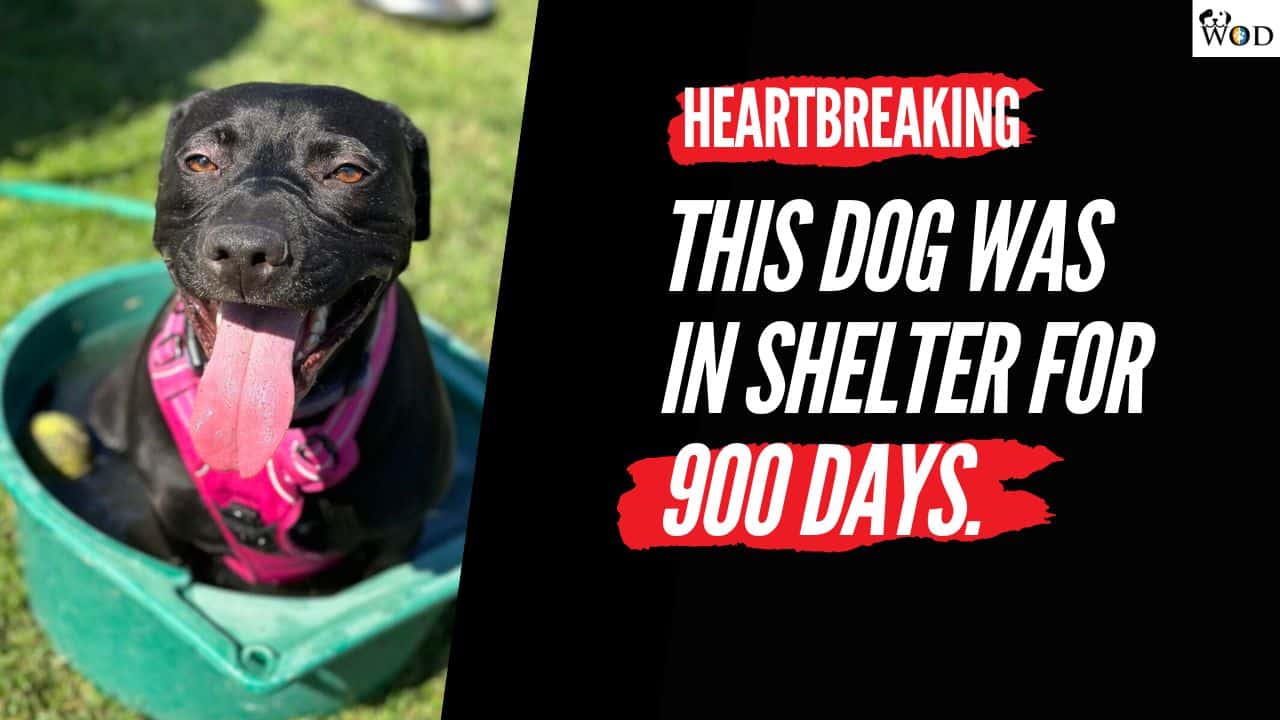Are you constantly wondering what’s truly the best diet for your muscular, energetic, and utterly lovable Pitbull? You’re not alone! Navigating the world of dog nutrition can feel like a maze, especially when you’re dedicated to ensuring your four-legged friend gets only the best.
The best diet for Pitbulls should be high in protein from quality sources like lean meats, balanced with healthy fats and essential nutrients. Include whole grains and vegetables for fiber, and avoid foods with fillers or artificial additives.
You must tailor the diet to your Pitbull’s age, activity level, and specific health needs for optimal well-being.
In this blog, we’ll explore the essential nutritional needs of Pitbulls and guide you through choosing the most beneficial and wholesome foods for them.
Whether you’re a new Pitbull parent or have been sharing your life with these wonderful dogs for years, this guide is packed with valuable insights and practical tips to ensure your Pitbull enjoys a balanced, nutritious diet.
Let’s get started!
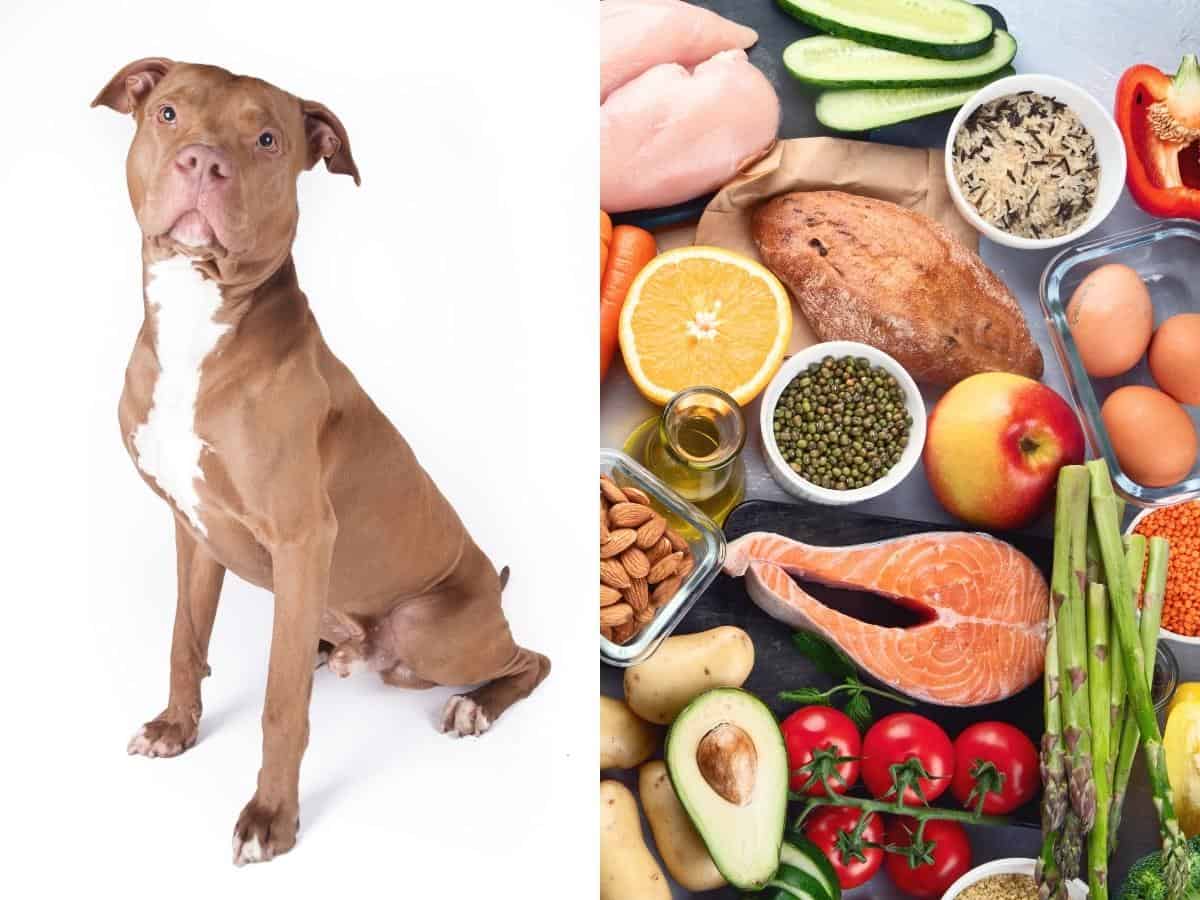
Key Nutritional Requirements
The nutritional requirements of Pitbulls are a minimum of 22% protein during growth stages and 18% protein for adult dogs.
Puppies need 8% fat, and adults require 5% fat to meet their energy needs. Carbohydrates, vitamins, minerals, and water are also necessary for survival.
You must include these essential nutrients in your Pitbull’s daily diet as they are required for all of the body’s vital functions.
The nutritional content of all commercial pet foods has to follow the guidelines developed by the AAFCO (Association of American Feed Control Officials).
The MSD Vet Manual also publishes dog nutrient profiles which contain in-depth detail listing all the individual vitamins and minerals a Pitbull’s diet needs.
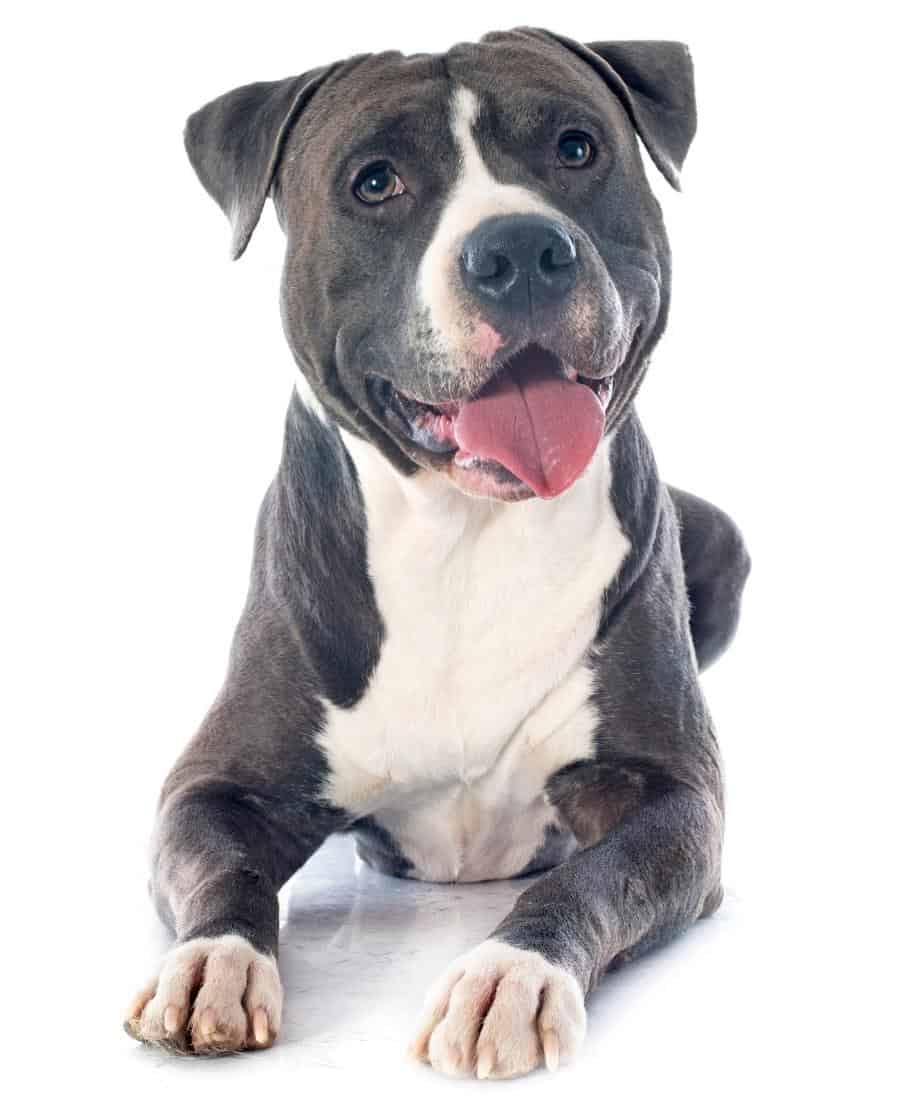
What’s The Best Diet For Pitbulls?
When considering the best diet for your Pitbull, choose foods with high-quality animal-based protein sources, such as beef, chicken, lamb, pork, eggs, fish, and plant-based proteins, such as grains, legumes, and vegetables.
Protein is the main nutritional requirement for dogs and has several functions:
- Provides energy.
- Builds and repairs muscles.
- Forms new skin, hair, and nail cells.
- Keeps the immune and musculoskeletal systems strong.
The second main nutritional requirement of a Pitbull’s diet is fat. Fat comes from protein and provides energy. It is also essential for the normal development and function of body cells, nerves, muscles, and tissues.
Your Pitbull’s diet will also have different nutritional needs depending on life stage, size, breed, activity level, and overall health:
- An active and growing puppy may need twice as many calories as an adult Pittie.
- A pregnant or lactating dog will need considerably more calories.
- An elderly Pitbull may need 20% fewer calories in their diet than middle-aged dogs.
For example, a well-exercised adolescent Pitbull will require a completely different diet than a more sedentary elderly Pittie.
So, what are the recognized life stages of dogs? The AAFCO defines them as:
- Gestation/lactation (pregnancy and nursing).
- Growth (includes puppies).
- Adult maintenance.
- All life stages.
So that got me wondering: what exactly does “all life stages” mean?
A Pitbull diet for all life stages meets the nutritional requirements for growth, reproduction, and adult maintenance. This diet is, therefore, suitable for Pitbulls of any age.
One thing to mention is that an “all life stage” diet is generally higher in calories, so you would only choose this diet depending on your dog’s situation.
For example, if your dog is an adult, inactive, or needs to lose a few pounds, you should choose a diet for adult maintenance.
If your dog is a working dog or highly active, you may choose a diet for “all life stages” due to the extra calories and nutrition.
Different quantities, ratios of nutrients, and feeding rates are advised for different life stages when selecting the right pet food.
Learn More About Dog Nutrition In This Video…
What Can Pitbulls Eat?
So now we know what nutrients Pitbulls need, let’s look at what they can eat. These are the primary foods of a balanced Pitbulls diet. However, they do come with some conditions, so read on!
| PROTEINS | GRAINS |
|---|---|
| Beef | Wheat |
| Chicken | Rice |
| Turkey | Oats |
| Venison | Oatmeal |
| Pork | Corn |
| Lamb | Maize |
| Duck | Rye |
| Liver | Quinoa |
| Kidney | Buckwheat |
| Heart | Barley |
| Fish | Teff |
| Salmon | Amaranth |
| Tuna | Millet |
| Mackeral | Spelt |
| Eggs | Bulgar |
| NUTS | DAIRY |
|---|---|
| Almonds | Cheese |
| Cashews | Cream |
| Peanuts | Ice-cream |
| Hazelnuts | Yogurt |
| Chestnuts | Milk |
| VEGETABLES | FRUITS |
|---|---|
| Artichoke | Apple |
| Asparagus | Apricot |
| Bell Peppers | Banana |
| Beets | Blackberries |
| Broccoli & Brussels Sprouts | Blueberries |
| Cabbage & Cauliflower | Coconut |
| Carrot | Cranberries |
| Celery | Cucumber |
| Corn | Dates |
| Cucumber | Kiwi Fruit |
| Eggplant | Mango |
| Green Beans & Peas | Melon |
| Lettuce & Kale | Nectarine |
| Parsnips | Peach & Plum |
| Pumpkin | Persimmon |
| Potato (cooked) | Olive |
| Rutabaga & Turnip | Pear |
| Spinach | Pineapple |
| Sweet Potato | Raspberries |
| Squash | Strawberries |
| Zucchini | Watermelon |
Here are the provisos of feeding the above foods:
- Meats should be lean with all the fat removed. Avoid processed meats such as salami, bacon, and sausage, as they contain lots of salt and seasoning.
- Most vegetables should be cooked first to help digestion; however, raw carrots and green beans are fine.
- Remove all pits and seeds from fruits, as they are a choking hazard. They also contain cyanide, which is toxic to dogs when consumed in large quantities.
- Don’t feed raw eggs or raw fish due to the risk of salmonella or listeria.
- Nuts are not recommended due to their high fat content, which can cause vomiting and diarrhea. They are also a choking hazard.
- Avoid dairy foods if your dog is lactose intolerant.
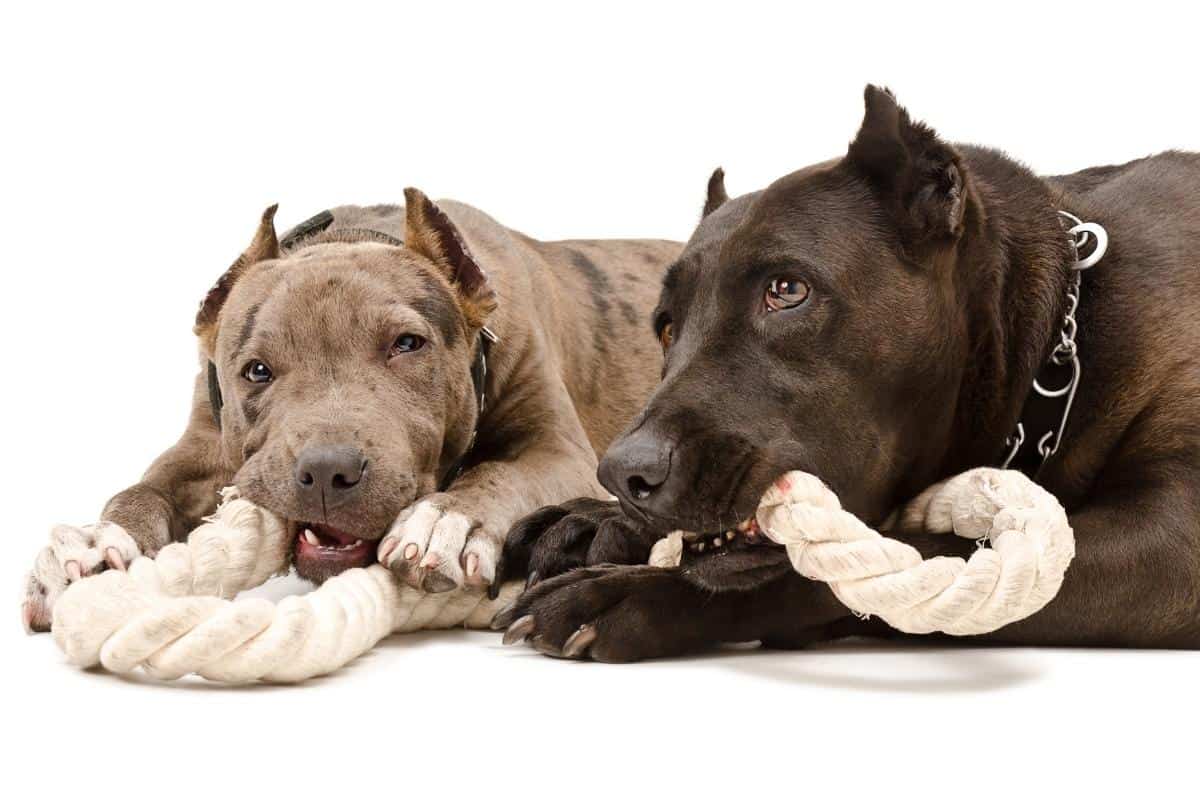
What Can Pitbulls Not Eat?
Pitbulls have a different digestive system from humans. Some safe foods for you and me can be harmful or even highly dangerous for Pitties.
These foods you should not include in your Pitbull’s diet as they are toxic. I have listed the main ones below in this table:
| Alcohol | Avocado | Caffeine |
| Chocolate | Grapes | Garlic |
| Hops | Horse Chestnut | Macadamia Nuts |
| Mushrooms | Nutmeg | Onions |
| Leeks | Cherries | Raisins |
| Rhubarb Leaves | Salt | Starfruit |
| Xylitol | Yeast Dough | Walnuts (Black) |
| Tomato (green) | Raw Potato | Shallots |
| Cocoa | Chives | Moldy food |
The Pet Poison Helpline lists many poisonous stuff, including plants, household items, and medications. It is an excellent resource, but hopefully, you won’t need their help if your Pittie avoids these.
Types of Dog Food for Pitbulls
We all want the best for our pets and want to feed our Pitbull the best diet. But, there are so many types of dog food it can get overwhelming, and it’s difficult to know where to start.
The Pitbull breed is actually a term for several breeds, including the American Pit Bull Terrier, American Bully, American Staffordshire Terrier, Staffordshire Bull Terrier, and any crossbreed that shares specific physical characteristics with these breeds.
Although Pitbulls vary in size, they are predominantly stocky, muscular, and powerful, with a broad head, strong neck, muscular jaws, and a broad chest.
The average adult male Pittie weighs 35 to 65 pounds, while females typically weigh 30 to 60 pounds.
So, here’s the thing.
The best dog food for Pitbulls is dry food, which is more practical for the muscular Pitbull. It is also the least expensive, even if you choose a top-quality brand.
Of course, you can feed other diets, such as:
- Canned wet foods
- A mix of dry and wet
- Home produced diet
- Raw diet
- Dehydrated
- Freeze-dried
If you choose commercial dog food, it must be ‘complete’ and ‘balanced’ according to the strict guidelines of the AAFCO.
‘Complete’ means “the food must contain all the nutrients required,” and ‘balanced’ means “the nutrients present must be in the correct ratios.”
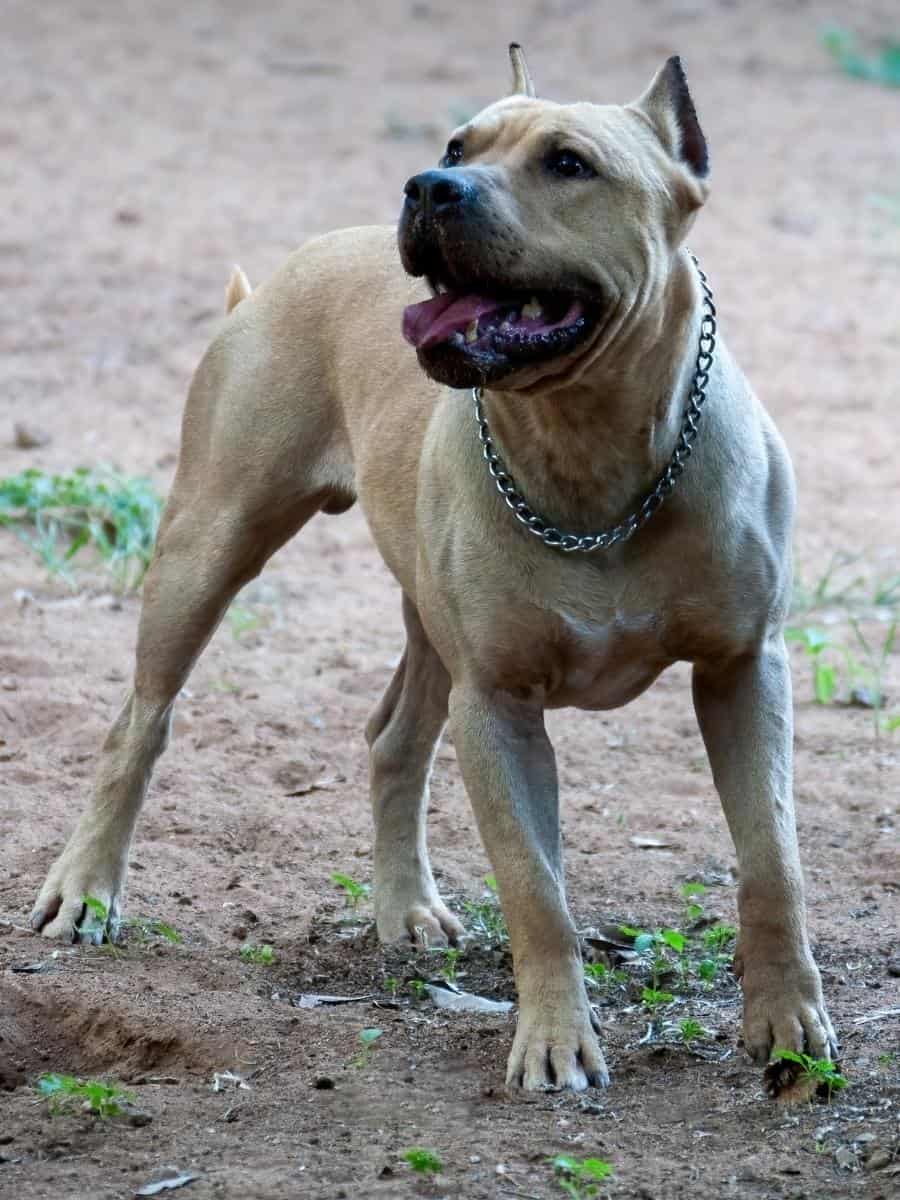
The AAFCO also provides information on understanding dog food labels. It’s a pretty heavy read, but in essence, it means that manufacturers will nutritionally label dog food depending on the dog’s life stage.
If you choose to feed commercial dog food (dry, wet, or mixed), always check the packaging for what is known as “The Nutritional Adequacy Statement.”
It was designed for vets, nutritionists, and dog owners to evaluate the food’s nutritional value to their pets.
This statement should say that the food meets nutrient profiles established by the AAFCO according to the dog’s life stage or passed feeding tests designed to AAFCO standards.
High-quality protein sources (beef, pork, chicken, lamb, etc.) should be high on the list of foods for your Pitbull, as should quality sources of grains or vegetables and fats.
You should also check that vitamins and minerals are included. The best quality commercial dog foods will also contain additional protein sources, such as fish, eggs, and plant-based proteins, like vegetables, legumes, and grains.
The best diet for your Pitbull should suit his size and lifestyle. But not only is it important to satisfy your Pittie’s needs but yours as well! I will explain what I mean when we take a unique look at the different types of food you can feed your dog (see below).
Many pet food companies have invested millions of dollars into researching what ingredients contain the maximum levels to achieve a healthy, balanced diet that aids in essential puppy growth and mental and physical development.
Learn More About The Different Types Of Dog Food In This Video…
Let’s now look at the popular types of dog food that should help you decide on the best diet for your Pitbull.
Dry (Kibble)
Dry dog foods are one of the most popular choices. There are two main types of complete dry foods – KIBBLE and COLD-PRESSED DOG FOOD.
The latter is gaining popularity worldwide and is widespread in the UK and Europe. Cold-pressed food is deemed a higher quality kibble due to its cooking process.
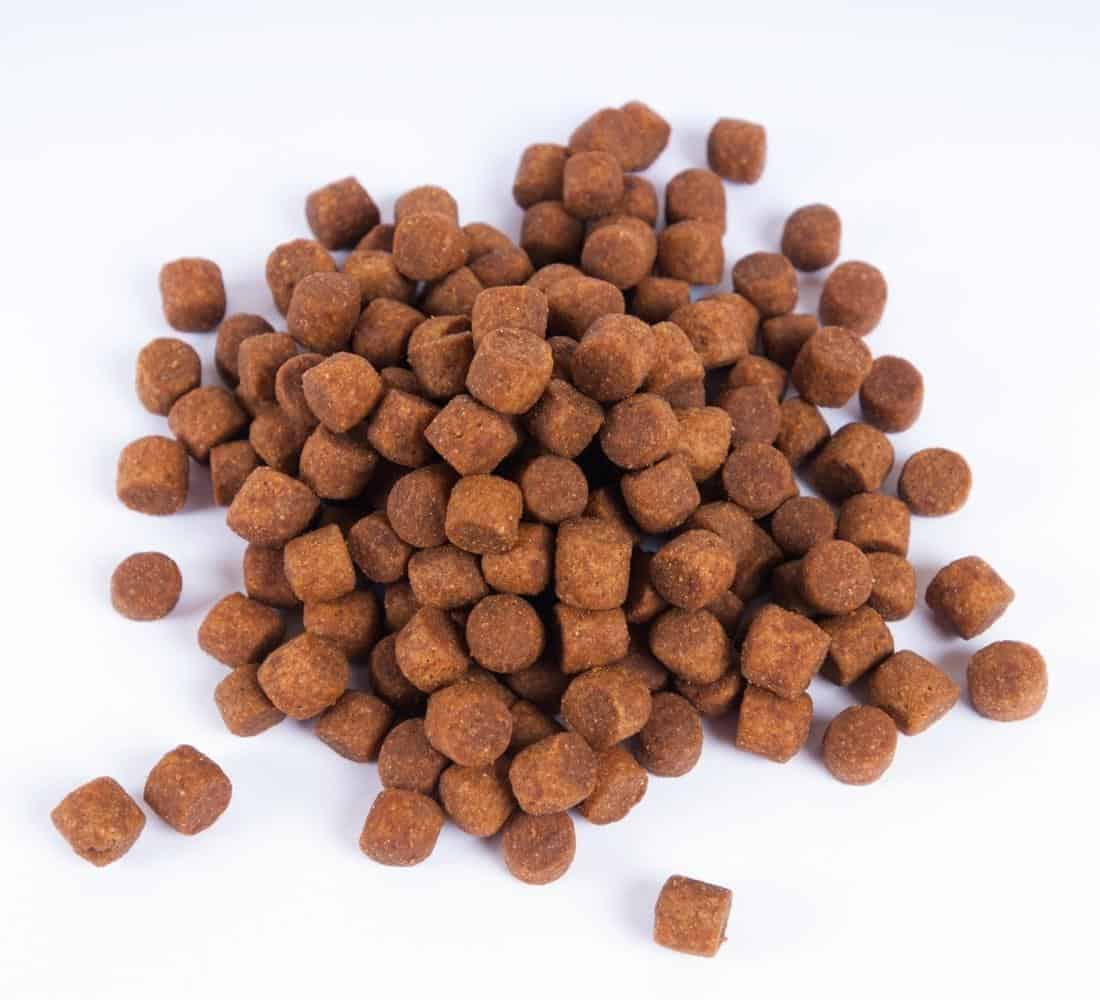
So, what exactly is kibble? Kibble is dry dog food made either through extrusion or oven baking. The food is produced under high pressure and high temperatures. All kibble is made the same way and using the same machinery. Even high-quality dry foods that use “human-grade” ingredients are made using the same process.
What is cold-pressed dog food? Cold-pressed dog food is dry food made at much lower temperatures and cooked quickly before being pressed into the desired shape. This unique method means the food retains more nutritional value, flavor, aroma, and vitamins. All the goodness is retained in bite-size pieces.
Dry dog food provides more nutrients per bite than wet food because it contains less moisture. That means you won’t have to feed as much to satisfy your Pitbull’s appetite and nutritional needs. You may give dry food completely dry or add water to make it into a tasty “broth.”
If you wish to compare dry food with canned wet food, dry costs less per serving, and there can be less waste as dry food can be left in your dog’s bowl for longer, unlike canned food.
Dogs with dental problems may also benefit from dry food as it helps to clean their teeth and gums.
Dry dog food is the most practical choice for a medium-sized dog, especially a Pitbull. However, dry food comes in all shapes and sizes, so a smaller-sized variety can be suitable for smaller Pitties.
It is also okay to feed your dog a pure, dry diet and add cooked meat, fish, or vegetables, which I do.
I feed my dog cold-pressed dog food, and although this is high-quality, I like to mix things up, so I’ll often add a small amount of cooked lean chicken, beef, salmon, or a spoonful of plain yogurt.
Occasionally, my dog will have some tinned tuna or mackerel in oil, which is also excellent for her skin and coat. If I add a topping, I always slightly reduce the quantity of the food to ensure that she is not gaining extra calories.
Wet (Canned)
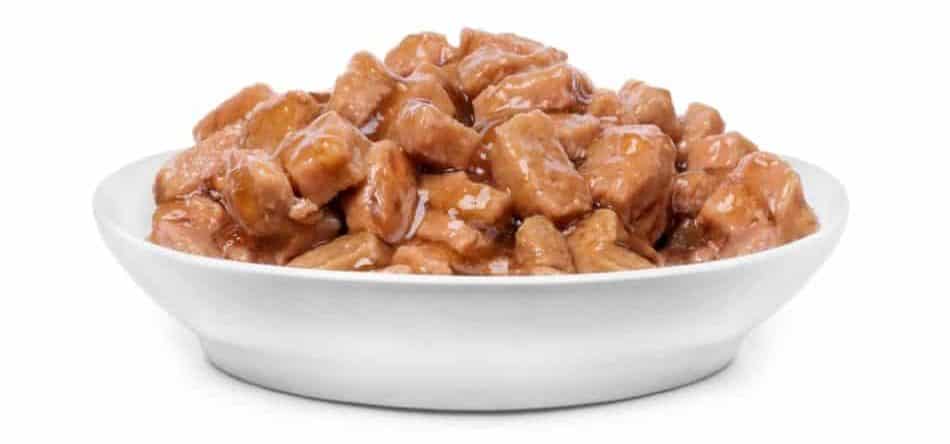
Canned wet dog foods contain high moisture content – around 75%. There are some things to be wary of; not every canned food brand provides the protein your Pitbull needs.
Also, the higher the water content, the fewer nutrients, so your dog has to consume more food to get the nutritional value their body needs.
Additionally, be wary of lower-quality canned foods, as manufacturers often add wheat flour as a thickener or extra white rice or other grains.
Canned dog food can be more expensive, especially if you have a solid muscular dog like the Pittie, but it may be ideal if your dog enjoys eating a more considerable portion.
Other advantages of wet food are that it may be more suitable if your Pittie is a fussy eater or if you have a senior dog who may have lost his appetite and find wet food more palatable.
Semi-moist Dog Food
Semi-moist dog foods are not as popular as other types as they offer the least nutritional value and can be pretty expensive.
Unfortunately, manufacturers add substances, such as sugar and salts, to preserve the moisture and shelf life.
Therefore, a semi-moist diet may not be appropriate for your Pitbull, especially if he is on the heavy side and needs to lose a few pounds.
Many semi-moist foods are also loaded with artificial colors, chemical preservatives, and flavor enhancers.
However, semi-moist food may be the best choice if your Pitbull finds it challenging to digest all other types of dog food.
Your dog may also enjoy the meaty taste and find this food more palatable if they are incredibly picky.
Semi-moist dog food is also very convenient because you simply need to open the pouch (usually resealable) and pour it into your dog’s bowl.
If you are considering this type of dog food, seek your vet’s advice to determine the calorie content of the food and an appropriate daily portion for your dog.
Dry Dog Food vs. Wet Dog Food
| Dry Dog Food | Wet Dog Food (including semi-moist) |
|---|---|
| More practicable for medium or large dogs | More practicable for a toy or small breeds |
| Inexpensive and less waste | More expensive than dry foods |
| Provides more nutrients per bite than wet | Good for picky and senior dogs |
| Convenient and easy to feed | Good for hydration if your dog doesn’t drink much |
| No need to refrigerate | There can be more waste if the food is uneaten |
| Good for “grazers” as can be left in the bowl longer | Good for dogs who have trouble chewing |
| Can add cooked meats, fish, or veg | It has a longer shelf life than dry |
| Can add water to make a tasty gravy | Dogs can enjoy a larger portion per meal due to the high water content |
| Available in many shapes and sizes | Some dogs find wet more palatable than dry foods |
| Great for interactive feeders | Look out for added salt and sugar |
| It can be good for the teeth | May contribute to gum disease |
A Mix of Dry and Wet
A third option is to choose a mix of both dry and wet foods. You can mix the foods in the same bowl or feed dry for the morning and wet for the afternoon feed (or vice-versa).
Some Pitbull owners who feed dry dog food like to add wet food as a topping for added moisture.
Again, you will need to ensure you’re not increasing your dog’s calorie intake if mixing these foods, and you may need to seek the advice of your veterinarian to ensure that you are feeding the correct nutrition. Should you choose this option, it’s easier to keep to the same brand.
| Pros of a Dry & Wet Mix | Cons of a Dry & Wet Mix |
|---|---|
| You get the best of both dry and wet | Need to track calorie intake |
| Can mix in the same bowl or at separate feeds | May require the advice of a vet |
| Provides variety | Recommended to keep to the same brand |
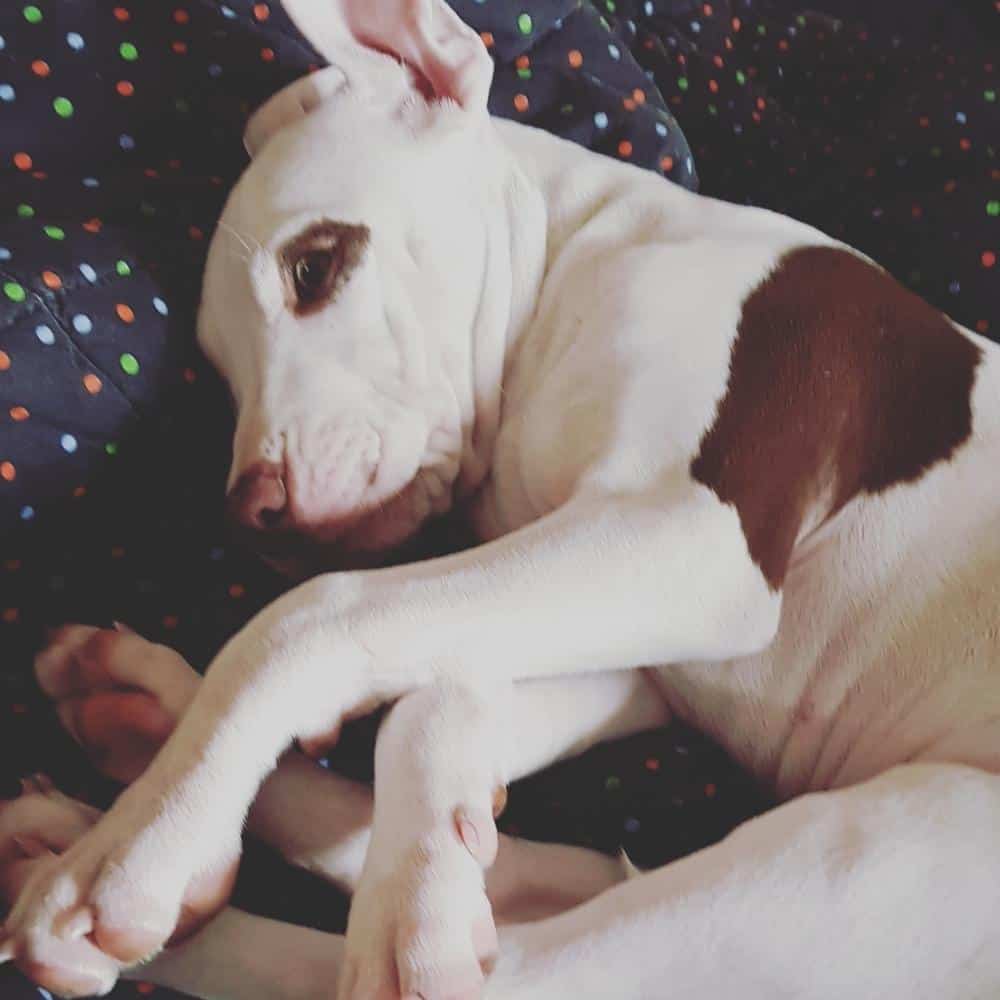
Homemade Diet
Some Pitbull owners feed their dogs a home-produced diet (known as home-feeders). If you’re wondering exactly why someone would want to be a home feeder, here are the main reasons:
- They sought alternatives to commercial pet foods as they were concerned about the nutritional value of the ingredients used.
- They simply enjoyed preparing the food and strengthening the bond with their dog or satisfying their views.
- They believe their pets will not like or refuse commercial dog food.
- They may need a home-prepared diet to help with a diagnosis (e.g., for a food elimination trial).
- They may require a home-prepared diet if a dog has a combination of diseases for which no commercial diet exists.
- They sought comfort as a home-feeder for dogs with chronic or terminal illnesses.
There are several drawbacks to the home preparation of dog food. You can do it, but it takes a lot of dedication and hard work, and it may be more expensive than even the best quality dog food on the market.
Homemade diets can provide complete nutrition. However, you need to make sure your Pitbull gets the right mix of protein, fats, carbohydrates, minerals, and vitamins, which is not easy to do.
Suppose you wish to prepare a home-cooked diet. In that case, it’s best to consult your vet or a pet nutritionist with the expertise to customize a healthy diet for your pet.
You can find their directory of professional nutritionists here. It’s by far a better option than relying on a dog recipe found on the internet that may not be nutritionally accurate.
It is recommended to cook all animal products to kill bacteria that could make your Pitbull sick. However, if you are a raw feeder (see below), you will likely disagree with this statement.
Grains, beans, and starchy vegetables must also be cooked to make them easier for your dog to digest.
Never add foods that are toxic to dogs. These include chocolate, grapes, raisins, onions, garlic, avocados, and macadamia nuts, to name but a few.
My closing thoughts on helping you decide on whether to become a home feeder would be:
- Do you have the time to become a home feeder?
- There are plenty of high-quality commercial dog foods on the market.
- Your dog will require regular health checks to check for any nutrient deficiencies.
| Pros of Home Produced Diet | Pros of Home-Produced Diet |
|---|---|
| You are in control of your dog’s food and nutrients | Regular health checks are advised to ensure correct nutrition |
| It may suit picky eaters | Expensive and time-consuming |
| Can help increase bonding | |
| Can assist with a medical diagnosis or healing |
Raw Diet
From three to four weeks onwards, it’s safe to start feeding a Pitbull puppy raw food. Raw feeding is founded on feeding dogs the foods they would have naturally consumed in the wild.
Occasionally, there will be a trend for feeding dogs an all-raw diet (e.g., raw meat, fish, and veg) instead of specially formulated dog food.
However, it’s essential to ensure that your Pitbull gets all the nutrients it needs and isn’t at risk of poor health or disease.
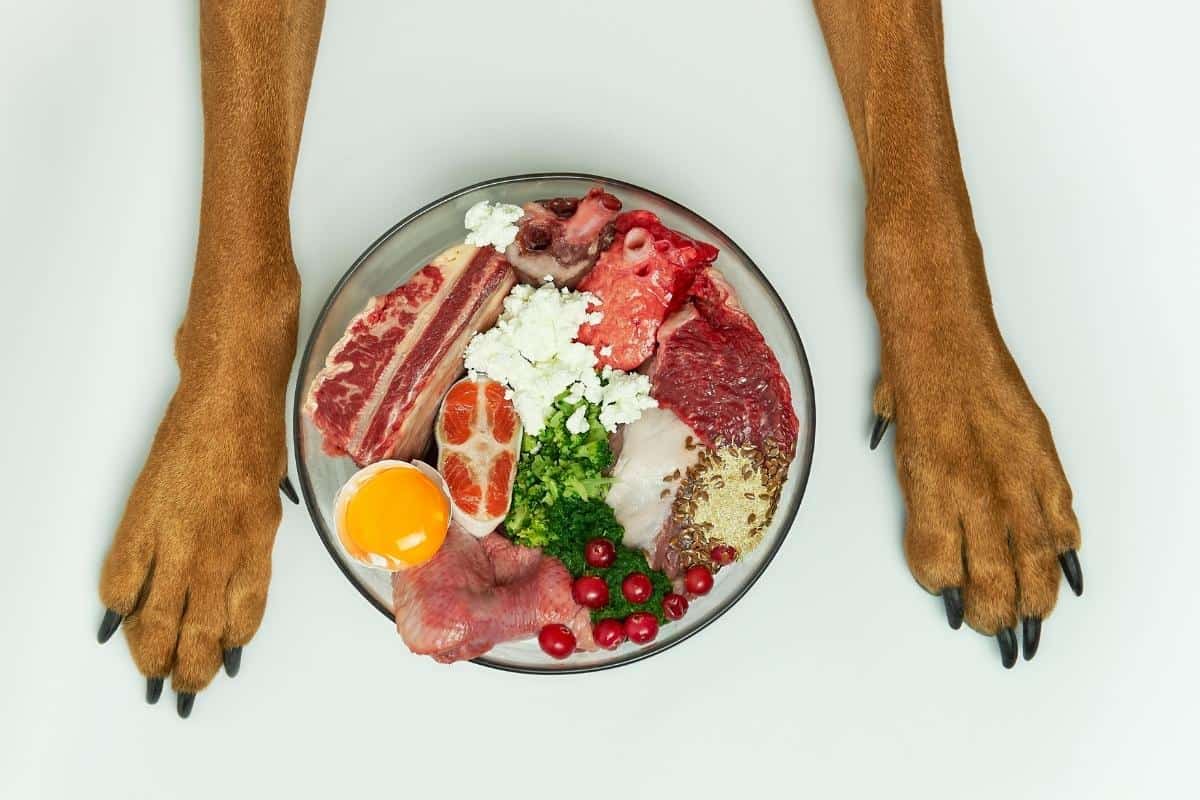
There are two crucial factors to consider when deciding to feed a raw diet to your dog. The first concern about raw feeding is ensuring you provide a complete and balanced diet, which is especially important for feeding a growing puppy.
Like homemade diets, formulating raw diets can be difficult, especially if your Pitbull is pregnant, lactating, or sick and therefore has different nutritional requirements.
It can be challenging to ensure you are not under or overfeeding essential nutrients. Again, you should consult your vet or a pet nutritionist before feeding raw.
The second most significant concern is food safety issues relating to bacterial or parasitic contamination. Food poisoning is also a main worry, and we cannot underestimate the health aspects of feeding raw foods to our pets.
Suppose you are contemplating feeding your Pitbull a raw food diet. In that case, you should ensure you follow the guidelines for the safe and proper handling of raw foods and are aware of all the associated food safety issues.
If you’re considering a raw diet for your Pittie, check out this video on raw vs. dry dog food to help you decide.
Many raw-feeders will claim that feeding a raw diet has numerous health benefits for your dog, including better digestion, shinier coat, healthier skin, stronger teeth, less disease, and generally living a longer and healthier life.
However, according to the American College of Veterinary Nutrition, the vast majority of the presumed benefits of feeding raw foods remain unproven:
If you choose a raw diet for your Pitbull, you have the option of preparing the food at home, or you can purchase commercial raw food products.
These range from complete foods, usually frozen or freeze-dried, to grain and supplement mixes combined with raw foods.
| Pros of Raw Diet | Cons of Raw Diet |
|---|---|
| You control your dog’s food and nutrients | Need to ensure proper nutrition is provided |
| Aids better digestion | It may be unsuitable for sick or senior dogs |
| Better stools | Risk of food contamination |
| Cleaner teeth and better breath | No proven health benefits & health checks advised |
Dehydrated and Freeze-Dried
You can choose to feed your Pitbull a dehydrated or freeze-dried diet. Both have become increasingly common in recent years.
These diets are similar in that they extract moisture from the food to preserve it and eliminate the need for artificial preservatives, but they vary in several ways.
Dehydrated
Dehydrated foods are partially cooked at low temperatures to extract most water. The food is heated but not fully cooked, so nutrients and enzymes remain whole. They are a complete diet frequently seen as a step up from ordinary extruded kibble.
Add warm water to dehydrated dog food to make it edible. As a result, the food has a texture comparable to canned wet food but is much less refined.
These foods are easy to store and prepare and have a long shelf life because they do not need refrigeration.
A dehydrated diet is also a good option if your Pitbull has a sensitive stomach, as the food is easier on the digestive system due to the gentle cooking method.
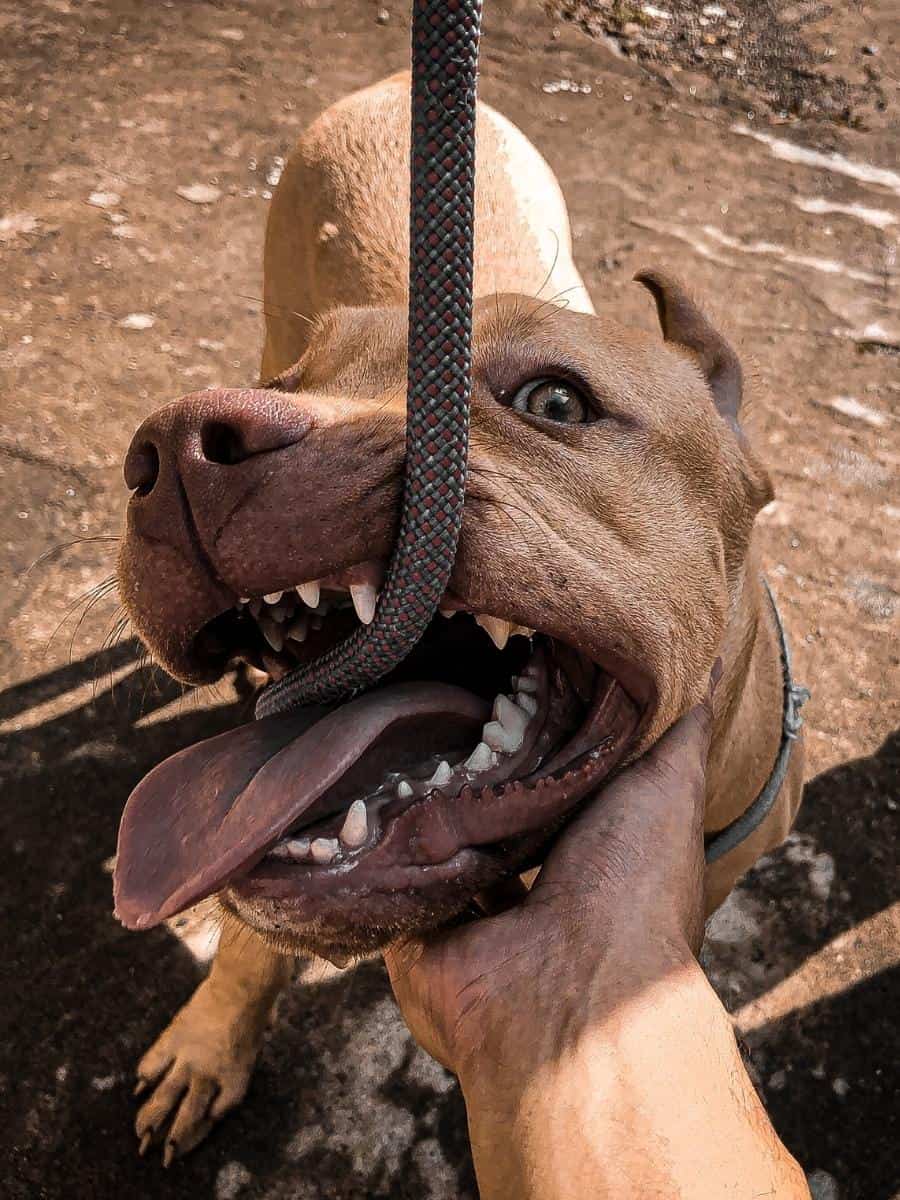
Freeze-dried
Freeze-dried foods are essentially a raw diet that has been repackaged.
The raw ingredients in freeze-dried dog food are frozen first and then placed in a strong vacuum to turn the moisture into vapor.
After that, the food is sealed in an airtight container. Unlike a true raw diet, this method reduces the number of bacteria such as salmonella.
Although freeze-dried food looks like kibble and does not need to be rehydrated before eating, your Pitbull will find it more palatable and digestible if you add water first.
Freeze-dried foods are usually very high protein diets with fruits and vegetables occasionally added.
This dog diet is an excellent alternative if you want to feed a raw diet but don’t like to handle raw food but want to provide a healthier and less processed diet.
You can also incorporate freeze-dried into your Pitbull’s diet by combining it with other types, such as kibble or wet.
Freeze-dried foods are more expensive than regular kibble, but as the food has the most moisture removed, they are more nutritionally dense, so you feed your Pitttie less.
| Pros of Dehydrated & Freeze-Dried | Cons of Dehydrated & Freeze-Dried |
|---|---|
| Nutrients remain intact | Very expensive |
| No added preservatives | Freeze-dried foods may still contain bacteria |
| Convenient | Freeze-dried products might be hard to source |
| Long shelf life and easy to store |
How Much Food Should a Pitbull Eat?
The food your Pitbull needs primarily depends on your pet’s size, activity level, age, and overall health. The key is to ensure you don’t overfeed or underfeed your dog.
An active adult Pitbull weighing 50lbs (23kg) needs 1353 calories a day, whereas an active, smaller Pitbull weighing 30lbs (14kg) needs 922 calories a day.
In contrast, inactive Pitties of similar weights only need 989 calories and 674 calories, respectively.
You also need to assess your dog’s activity level. Pitbulls who get minimal exercise may need 10% less than what’s recommended on the food label, whereas an active dog that regularly exercises may need 20% to 40% more.
Working Pitbulls may need food designed for working or performance dogs, such as search and rescue dogs. These foods have a higher fat content to provide extra calories for their needs.
Additionally, you may need to make adjustments based on your dog’s health or body condition. Illness, pregnancy, or nursing can also increase a dog’s energy needs.
All commercial dog food will have recommended feeding guidelines on the packaging. I also found this helpful dog calorie calculator you can use.
Finally, refer to the National Research Council’s science-based guide for your dog’s nutritional needs or consult your veterinarian.
Pro Tip: Although dogs can eat just once daily, most Pitbull owners prefer feeding twice daily. Giving two meals daily makes it easier for the dog to digest the food, which helps control hunger and bloat (GDV), a life-threatening condition.
Quantity Guidelines for Puppies
So, what about puppies, you may ask? How much should you feed a Pitbull puppy?
A Pitbull puppy needs about twice as many calories per pound of body weight as an adult Pitbull. Therefore, a large puppy weighing 35lbs (16kg) needs around 1740 calories, the same as an active adult twice its weight.
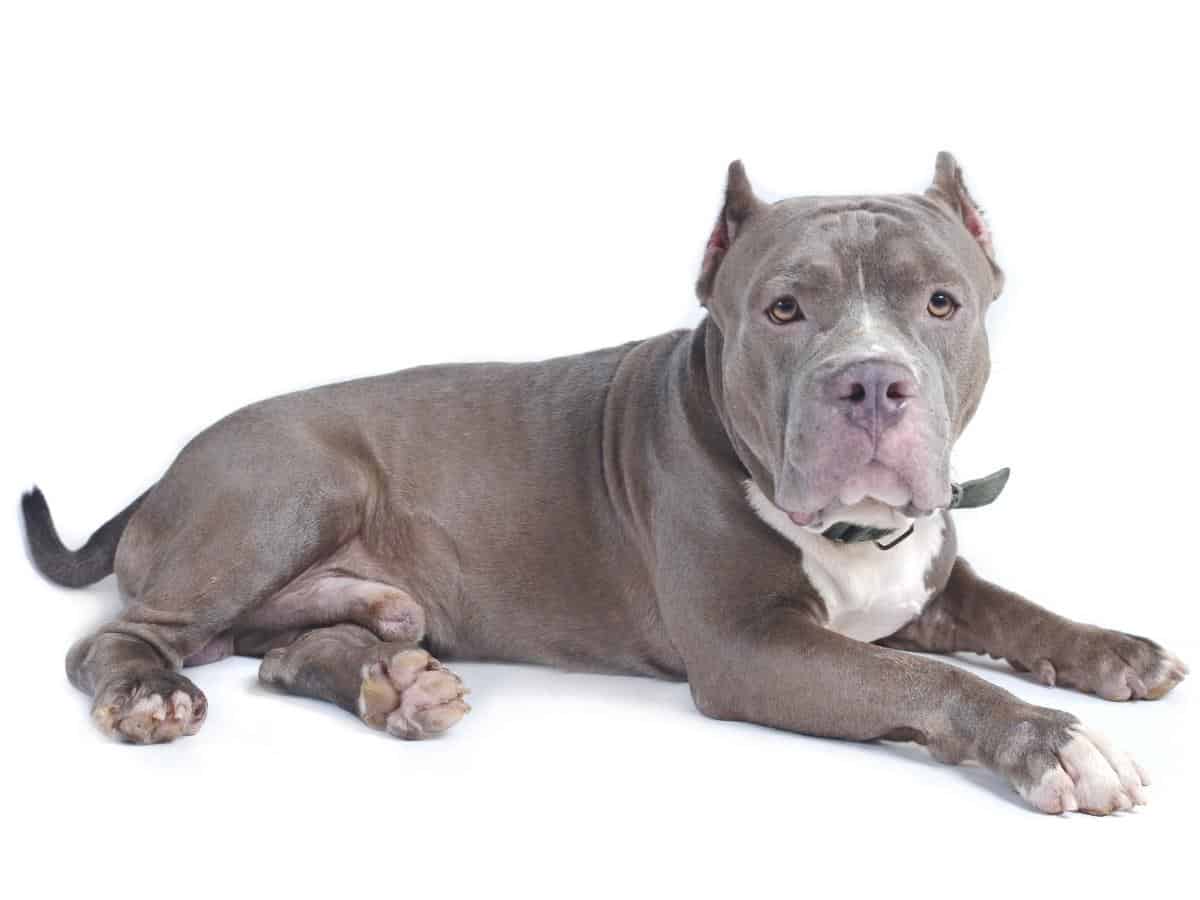
If you are feeding commercial dog food, your brand choice will have the recommended feeding guidelines on the packaging for puppies (and adults). In addition, most brands display helpful tables or calculators on their websites.
If you’re feeding your Pitbull puppy a home-produced or raw diet, you’ll need to calculate the daily calories so you’re not under or overfeeding.
Pro Tip: When your Pittie is a growing puppy, visit your vet monthly to weigh him and get a quick overall check of his general health.
How Often To Feed a Pitbull Puppy
Puppies receive all the relevant nutrients from birth by feeding on their mother. However, it’s safe to begin the weaning process onto a new diet for your Pitbull puppy after three to four weeks.
As mentioned, a growing Pitbull has different nutritional needs than an adult dog. But did you know puppies also need feeding more frequently at various stages of growth?
Pitbull Puppy Meal Plan
You should feed your Pitbull puppy four meals daily between 6 and 12 weeks old. Puppies aged between 12 and 24 weeks require three meals a day, and from 24 weeks onwards, Pitbull puppies should be fed twice per day.
| AGE OF PUPPY | DAILY MEALS |
| 6 to 12 weeks | 4 |
| 12 to 24 weeks | 3 |
| 24 weeks onwards | 2 |
Pitbull Puppy Diet
Growing Pitbull puppies need to take in enough calories, fat, protein, vitamins, and minerals to meet the rapid growth that will set them on the right path to a healthy life.
They should continue on a puppy diet until adulthood, up to 18 months in larger Pitbulls.
However, you may choose to feed your Pitbull a puppy diet only for his first six months, as you can switch early to adult food to help prevent too-rapid growth, which can lead to bone and joint issues.
This is fundamental as Pitbulls are susceptible to bone and joint issues such as hip dysplasia.
Many puppy foods explicitly labeled for large breeds are formulated to address these issues. Although Pitbulls are categorized as medium-sized, they often exceed 60lb and may be more suited to a large-breed formula.
Therefore, when deciding when to transition to adult food, you should consider the heritage of your Pittie and whether he is genetically related to a larger breed and likely to be larger as an adult.
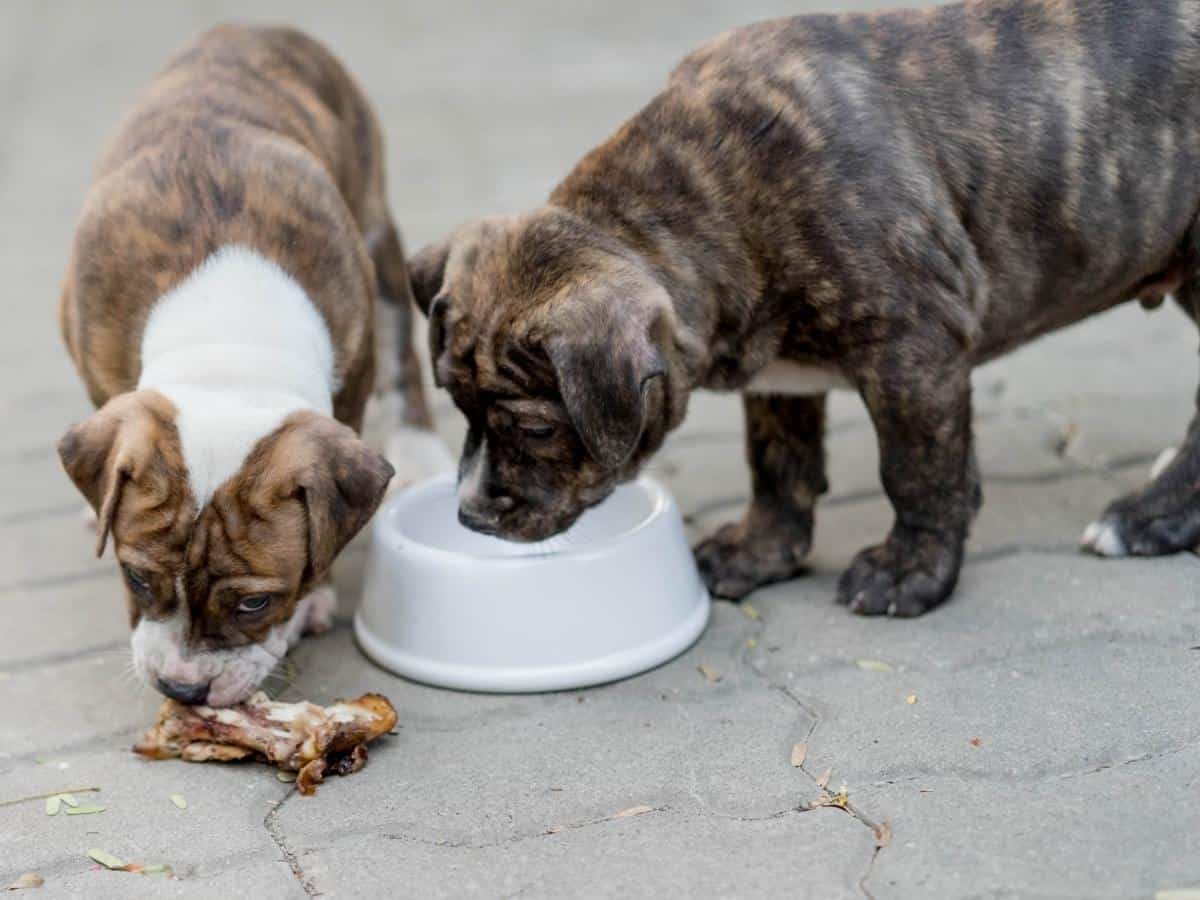
FAQs
What Are The Best Treats for Pitbulls?
The best treats for Pitbulls are carefully formulated for dogs and contain high-quality, nutritious ingredients. They should be low in fat and calories and free of additives, chemicals, and coloring.
How Much Water Should a Pitbull Drink?
Adult Pitbulls should drink one ounce (30 ml) of water daily for each pound they weigh. Puppies will generally consume more water despite their smaller size. Some variables include age, size, activity level, type of food eaten (dry or wet), weather, medication, or if they are nursing.
Ensure you keep your dog’s water bowl filled up and frequently change it throughout the day. If your dog is not drinking enough water, here are some fun ways to keep him hydrated:
- Give your dog ice cubes.
- Make doggie ice pops.
- Add water to dry food.
- Make fun playtime with a hose in the summer.
- Get a dog water fountain.
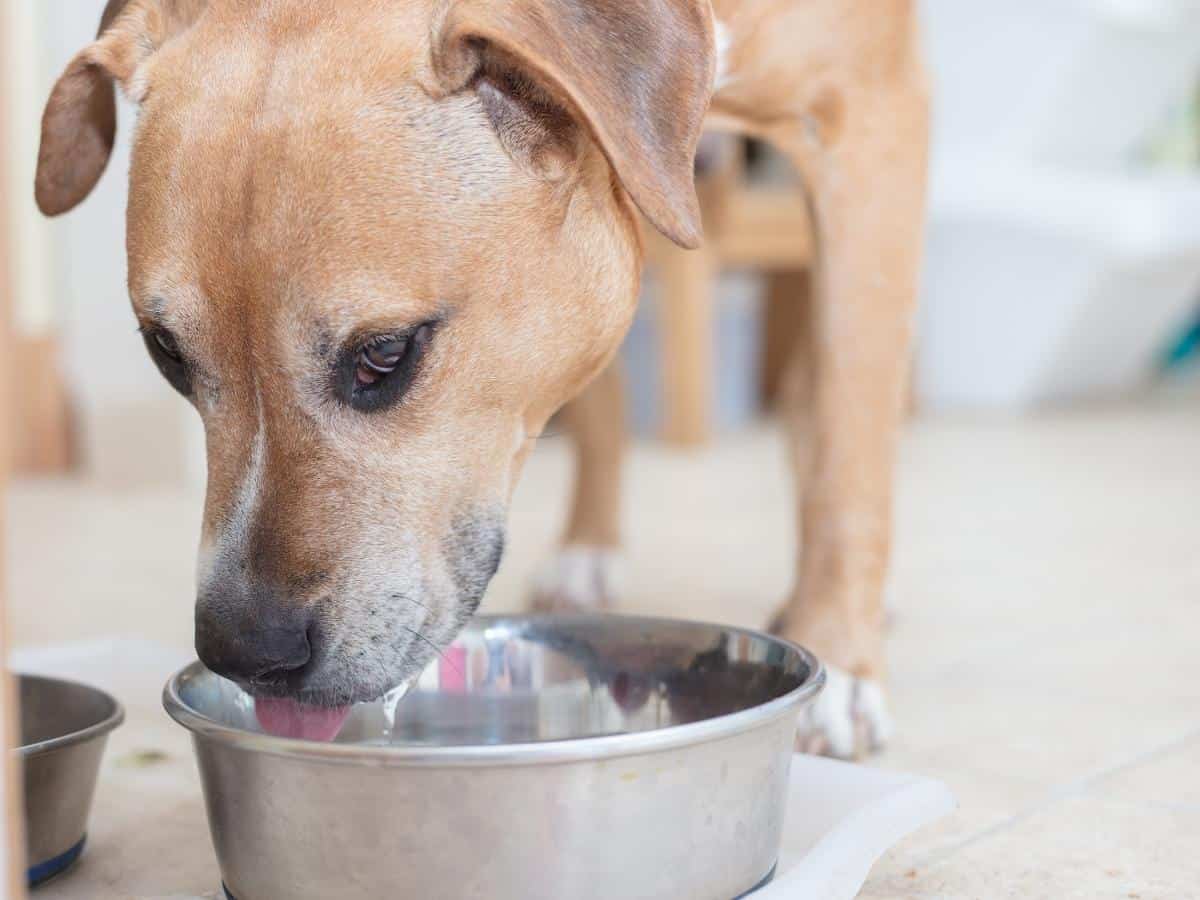
Can Pitbulls Eat Bones?
Pitbulls can eat bones, although they are meant to curtail chewing and are for recreation. However, they are a good source of nutrients, especially calcium and phosphorus, and help clean your dog’s teeth and keep them strong.
But never feed a cooked bone as cooking causes the bone to soften and splinter as your pup chews it and can cause injuries or choking.
Choose a sizeable raw bone larger than your dog’s muzzle so he won’t be tempted to swallow it. Beef or lamb bones are better than chicken or pork bones as they are stronger and won’t easily splinter.
Do Pitbulls Need Vitamins?
Healthy Pitbulls don’t need to add vitamins or supplements to their diet if they eat good quality, complete, balanced pet food. You should only give your dog vitamins or supplements if your veterinarian recommends them.
Nonetheless, some dog owners like to add fish oil as a dietary supplement to promote skin health and support the immune system. Others like to provide Glucosamine and Chondroitin for joint support.
Are Pitbulls Omnivores or Carnivores?
Pitbulls are omnivores, not carnivores. Dog domestication over thousands of years has caused dogs to adapt to a starch-rich diet. Therefore, a Pitbull’s digestive system can process both plant and animal food, and their teeth (molars) can grind down fruit and vegetables.
Final Thoughts
To wrap it up, the best diet for your Pitbull is one that’s rich in protein, balanced with healthy fats and nutrients, and tailored to their specific life stage and activity level.
By choosing the right foods and avoiding unhealthy additives, you’re setting the stage for a long, healthy, and joyful life together with your beloved Pitbull.
Always remember, when in doubt, a quick chat with your vet can help guide you to the perfect meal plan for your furry friend
Related Posts You May Like:





